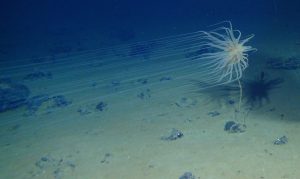
Photo Credit: NOAA
There is widespread concern about the impact deep-sea mining will have on the ecosystems and habitats of the deep. Alongside this, there are questions being asked about whether deep-sea mining is necessary or desirable, and whether it is economically viable.
Environmental impacts
Deep-sea mining is still in the experimental stage, and the impacts on deep-sea ecosystems remain unknown. But existing information has led scientists to warn that biodiversity loss will be inevitable – and most likely irreversible.
- On the abyssal plains, sucking up nodules would involve destruction of the seabed leading to the potential extinction of species. The nodules themselves support complex ecosystems, which would be lost. Each mining operation would effectively strip mine 8,000-9,000 square kilometers of deep ocean seabed over a 30 year mining license period.
- Stripping seamounts of the outer layer of ‘crusts’ containing cobalt and other metals would destroy deep-sea sponge and coral ecosystems that are likely to have taken thousands of years to grow.
- Mining hydrothermal vents would destroy vent habitats and kill the associated organisms before the biodiversity of these unique and fragile ecosystems is well understood.
As well as the direct and immediate impacts on the deep-sea ecosystems actually mined, there are likely to be wider effects on the marine environment.
- Plumes of sediment will be created as mining stirs up the seafloor, possibly spreading tens of thousands of square kilometers beyond the mining sites. The effect this will have on filter feeders such as corals and sponges is unknown.
- Wastewater containing sediment and mine tailings (or mining ‘fines’) pumped back into the ocean would also form plumes which may travel hundreds of kilometres or further which may be toxic and cause water cloudiness, impacting species that use bioluminescence to hunt or find mates.
- Noise, light pollution and sediment plumes could seriously impact species, such as whales, that use noise, echolocation or bioluminescence to communicate, find prey and escape predators.
Other risks
Deep-sea mining is expensive, and though it may be profitable to individual companies, questions have been raised about its wider economic benefits. The International Seabed Authority (ISA) is required by the UN Law of the Sea to license mining in the international areas of the ocean ‘for the benefit of mankind as a whole’. Recent calculations on mining in the deep abyssal plains suggest that the royalties that would be collected by the ISA for each mining license would only amount to a few hundred thousand US dollars paid to each ISA Member country per year.
Papua New Guinea, has already lost over US$ 100 million of its investment in deep-sea mining in its national waters in the Pacific. The Papua New Guinea government is now concerned about the environmental implications of deep-sea mining and in 2019 called for a moratorium (official delay) on deep-sea mining in its own waters. This call has been echoed by the leaders of Fiji and Vanuatu.
